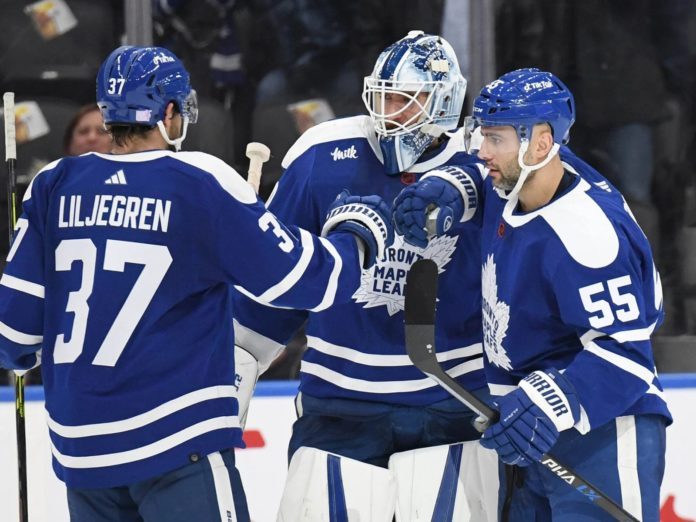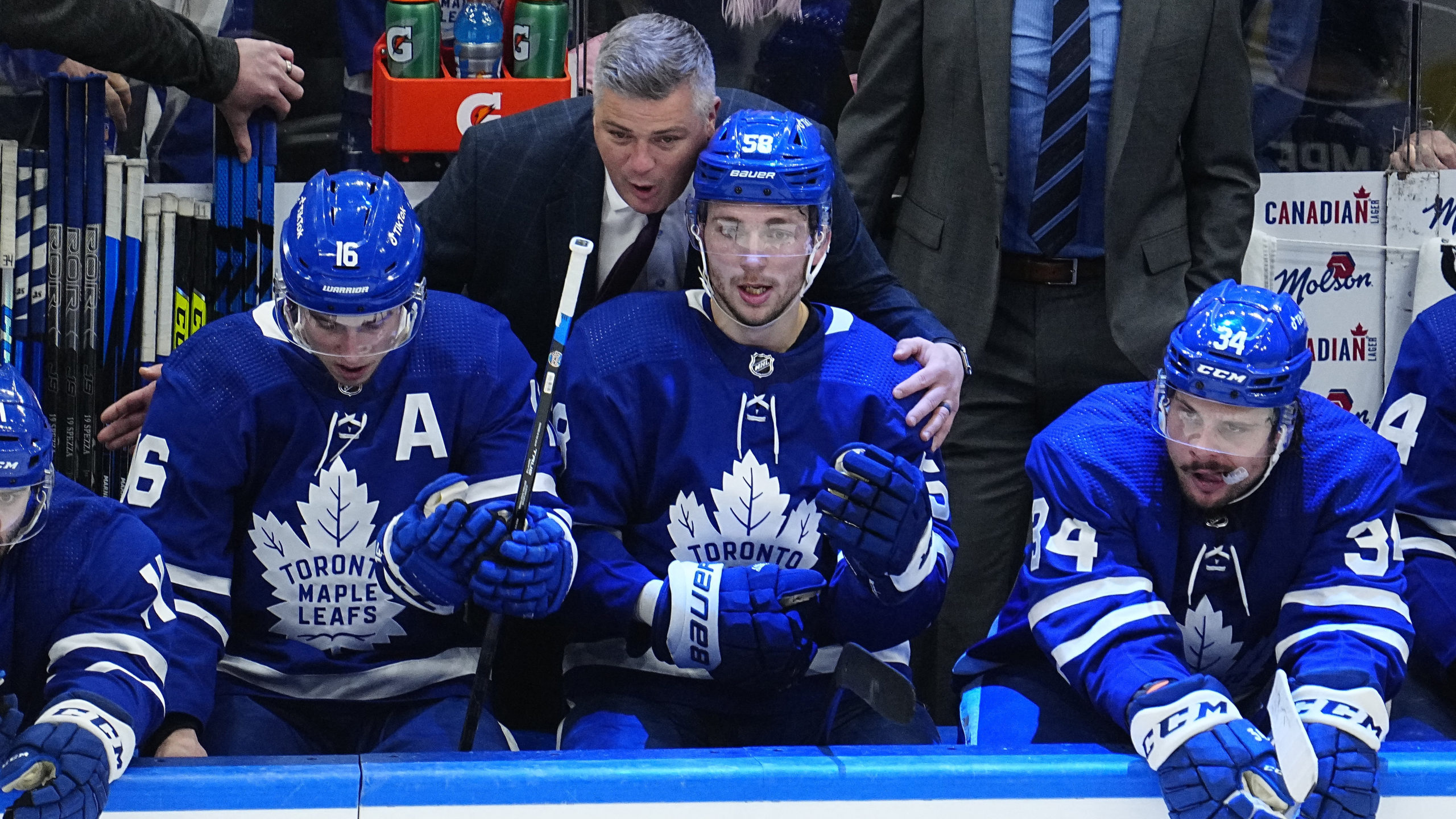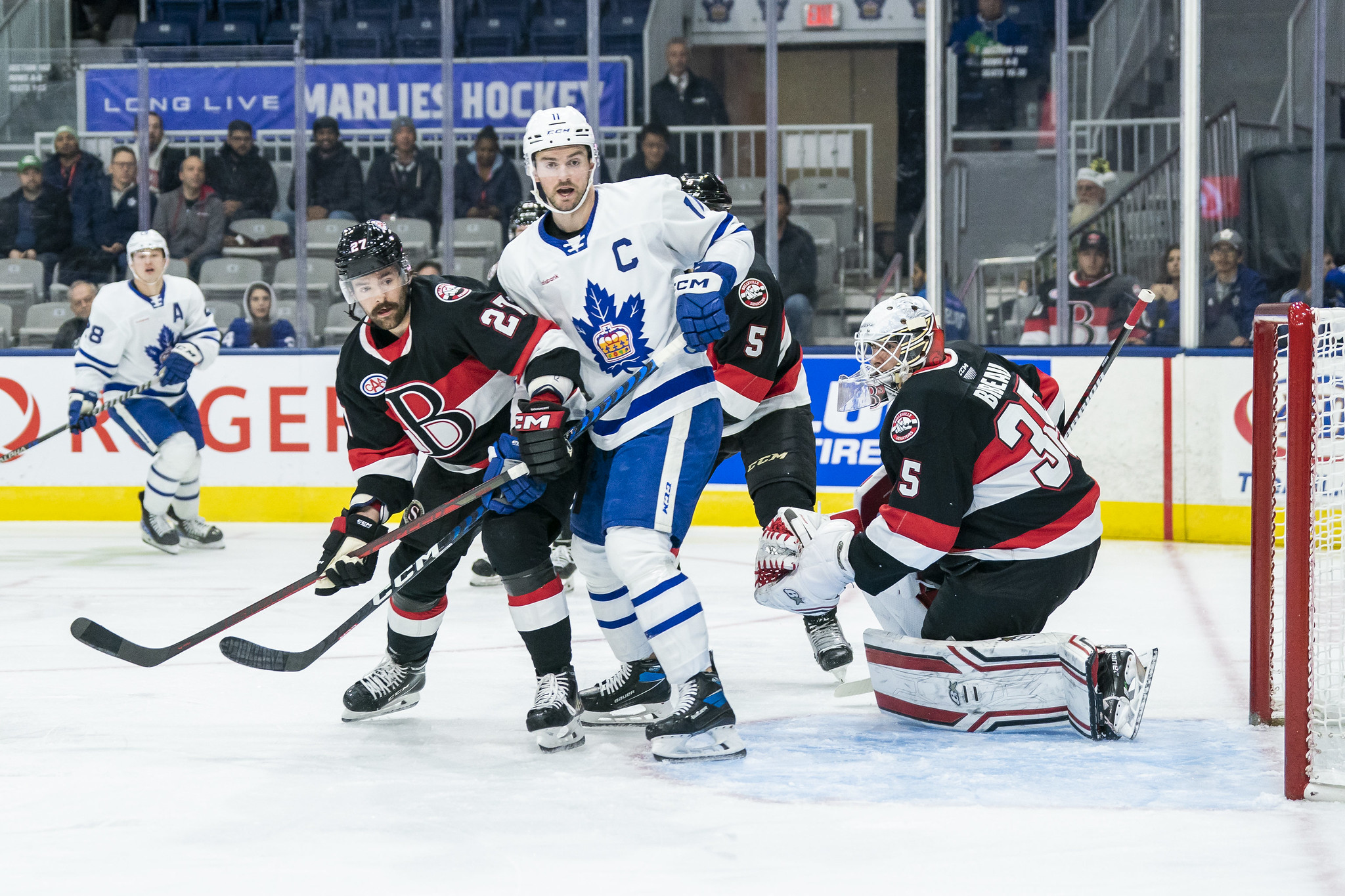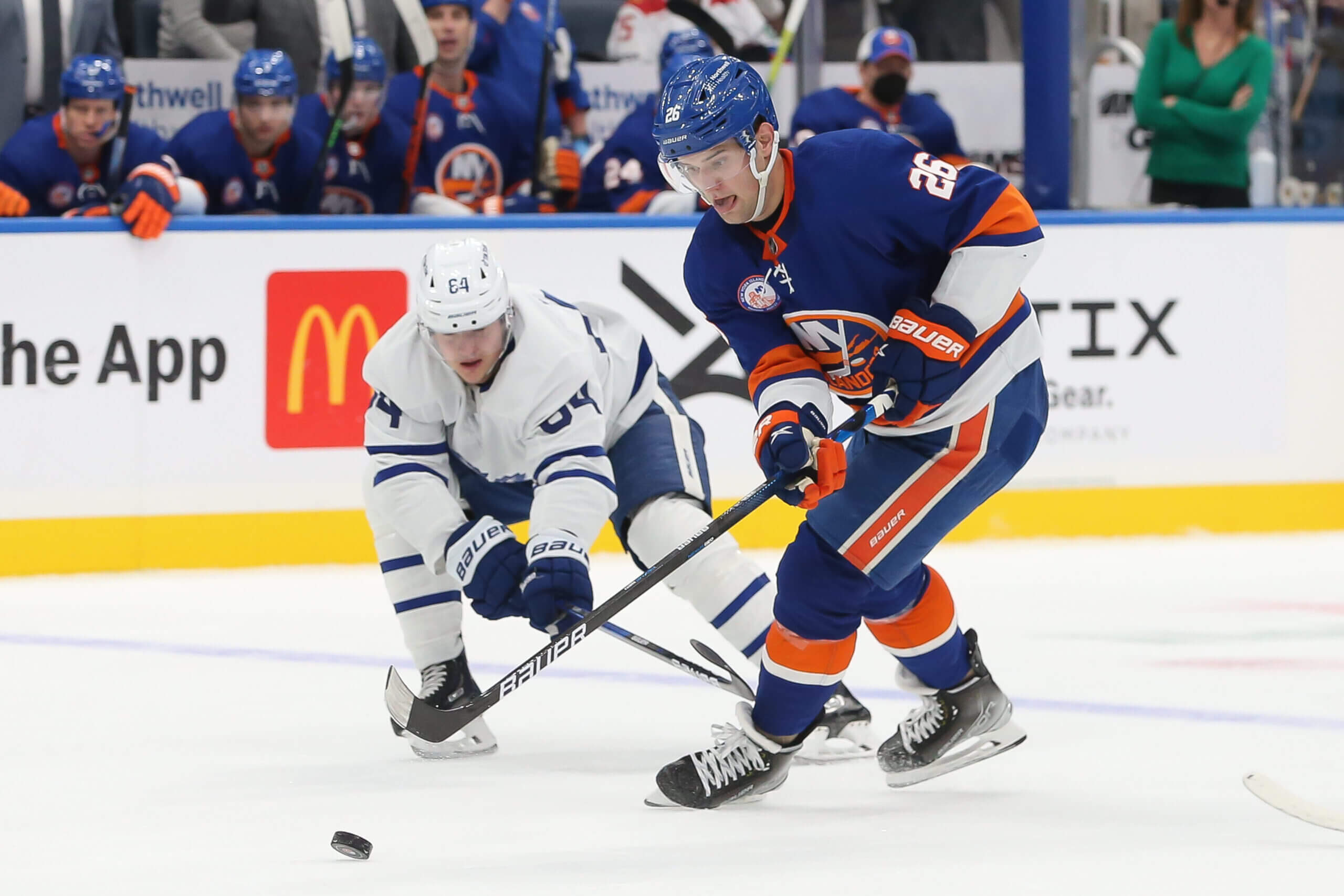
Maybe we just have to accept this is how it goes with this Maple Leafs team to start the season: A weak October filled with consternation in the market, followed by a massive November that quiets the baying wolves.
As it stands today, the Leafs sit third in the league in points percentage. Boston is three points ahead of them with two games in hand for first in the division and the league.
Naturally, the next question for Leafs fans is what does this team’s play portend for the springtime?
There are encouraging signs.
Last season, they gave up 3.07 goals against per game, a middle-of-the-pack ranking in the league. This season, that number is well down to 2.41, which is third-best. That comes thanks to a combination of improved goaltending and team defense so far.
There was a lot of criticism during those early-season struggles about the team signing defensive checkers to fill out their bottom six as opposed to players who can score – which was nonsense talk. Good checkers are a valuable asset, especially as the season wears on.
The goaltending has been strong, but it’s way too early to truly feel comfortable about it. Just last season, Jack Campbell also blacked out in November and went on a massive tear en route to an All-Star game appearance.
That said, it’s so far, so good in net, where they have two viable options compared to (sort of) one last season. Murray has more pedigree than Campbell to lean on, too, which isn’t nothing.
The Leafs’ defense is an interesting unit to sort out. Last season, Morgan Rielly and TJ Brodie played all 82 and were generally a strong pairing. The other pairings struggled, and they eventually were forced to split them up to spread the wealth. Jake Muzzin battled through a really disappointing season, and Justin Holl struggled alongside him. When they eventually paired up Brodie – Holl, the latter’s play settled down.
Timothy Liljegren did emerge as an NHL defenseman, and Rasmus Sandin was in the process of doing that as well but got hurt. Travis Dermott played 43 games as some fans still tried to convince themselves he was a viable top-four option hiding in plain sight. Eventually, Ilya Lyubushkin was acquired — bringing an element of jam — and Mark Giordano was acquired as a viable minute-eater.
Playing Giordano with Liljegren really helped bring along the latter’s game, in my estimation. Brodie remained with Holl and Lyubushkin played on the pairing with Rielly – a solid unit to be sure, but with a bit of a strange “top” pairing that carried through to the playoffs.
This season, the blue line has been banged up, but things are kind of falling into place. Jake Muzzin has, unfortunately, barely played. Brodie and Rielly have been hurt. They added depth options in Jordie Benn and Victor Mete, who are also both hurt. But Liljegren – who barely played in the playoffs – and Sandin – who didn’t play at all in the playoffs – have risen to the occasion and are becoming legitimate players in front of our eyes.
Giordano has been an absolute horse (hopefully, he can keep it going through the grind of the season), and Holl’s game has settled down alongside him. Now Brodie is back and Rielly is expected to return in short order, too. Muzzin remains a question mark (and even if he does return, what can they really expect?).
Most of the names remain the same, but Sandin and Liljegren developing along with Rielly – Brodie over Rielly – Lyubushkin is an improvement. You can likely argue at this rate that Giordano alongside Holl is a step above the quality of Muzzin – Holl’s play since the start of last season, even if Muzzin did put together a solid playoff.
In the playoffs, the shutdown pairing was actually Muzzin – Brodie. It’s a direct comparison of Rielly – Lyubushkin and Muzzin – Brodie vs. Rielly – Brodie and Giordano – Holl. To say nothing of the two youngsters on the third pairing who are emerging. It’s not a massive, full-blown upgrade, but the Leafs are so good that it’s about incremental improvements at this point in time. The pieces are in place to make those gains.
The Leafs also aren’t winning the same way as they have for years. They have grinded a lot more while locking games defensively at an elite level. Their top players score enough to win most games, and their goaltending has been strong.
They are always going to have to prove they can win in the spring – nothing they do now will convince anyone of anything otherwise. But while the results are roughly the same, they aren’t achieving them in the same way.
Notes

– With the Leafs rolling, I don’t think it receives enough attention how firmly Sheldon Keefe was on the team in the first month of the season. He called them out multiple times – most notably, after the loss to the Habs to open the season, the loss to Arizona, and pretty well the entire west coast trip. The team has obviously responded to him and is rolling now, which is no small feat.
It could easily have gone the other way. Keefe could have ridden out the poor start and poured cold water on the heat the team was facing during a weak first month, but he constantly called out his veteran team for unacceptable performances.
– I also have all the respect in the world for Keefe starting David Kampf in overtime against the Flames. I get that 3v3 overtime is a bit of a crap shoot, but a lot of the defeats have been self-inflicted and directly caused by poor puck management.
At some point, Keefe can’t continue to let it happen and hope it self-corrects. He’s almost left with no choice but to step in and send a bit of a message that enough was enough.
Earlier in that game in a spell of 4v4 play, they gave up a goal that started with poor puck management, too. The overtime period worked out and Keefe was able to make a joke out of it afterward, but it’s important to maintain some level of accountability.
– In the first month of the season, Michael Bunting struggled and was benched multiple times. I think a lot of the frustrations stemmed from him trying to be too cute. In his first game of the season, he was benched (despite scoring earlier in the game) against the Habs for making a drop pass around the offensive blue line that turned into a goal against. He was also missing chances, and the lack of finish was starting to frustrate him. In his first 16 games, he tallied six points.
He then broke out against Pittsburgh for a big three-point night, and from that point onward, he has 14 points in 13 games. Part of it has been his shooting percentage simply regressing to the mean – he is shooting pretty well exactly 1.7 shots per game in both of those stretches of play.
It’s also nice to see Bunting back to his style of game. Against Calgary, he scored a goal where he does his best work: in front of the net banking home a rebound off of the boards and in. He can get caught up in the antics at times, but when he goes to the dirty areas and simply makes plays there (winning battles, screening goalies, etc.), he’s at his best.
– It was disappointing to see Nick Robertson go down hurt just as there was an opportunity in front of him to string together games. There are a lot of smaller players in the league now, but they have to be strategic in how they play. Robertson’s aggressiveness and feistiness are admirable traits, but it’s going to be tough for him to stay healthy if he doesn’t adapt a little.
Matt Roy is listed at 6’1, 205 (which seems low), while Robertson is listed at 5’9, 183. Robertson geared up for a collision there, but it simply isn’t a physical matchup he should engage in. Now, he’s hurt for a while, and it’s a missed chance to string some games together in the top six and really solidify a roster spot.
– Against Calgary, Nikita Zadorov attempted to rough up Auston Matthews, and in response, he got a little push from Wayne Simmonds. It turned the power play into a four-on-four, where the Leafs got scored on. There was a lot of talk afterward about whether it was worth it, but to me, either you step in and get your money’s worth there or you do nothing. Simmonds was somewhere in between on that one.
If you’re Zadorov, you got a good cross-check in on an elite player, you got a little shove, it turned into four-on-four, and your team scored. That’s about as good as it gets. Either Simmonds should jump him, or the Leafs should make Zadorov pay on the power play.
– Later in the same game, Mark Giordano was in possession of the puck in the neutral zone and had Simmonds with him, so he laid the puck in the corner for him softly, setting up a big hit opportunity. Simmonds took a stride towards the corner and then decided to peel off instead. No hit.
Later in the game, Simmonds did have a moment where he laid a good hit – it led to a turnover and a positive shift – but it’s too few and far between. He made a weak pass to the point that was picked off and led to a scoring opportunity as well.
There has not been consistent enough physicality from him. There was a weak response to Matthews getting roughed up, which – had he not been playing – is the kind of thing fans would see and remark, “That’s why Simmonds should be in the lineup.” Clearly not. Hearing Simmonds talk, it’s hard not to root for him, but the play on the ice is not matching up.
Quotes

“We’ve selected an individual whose impact on our lineup and in our dressing room this season has been immediate. Logan has in a short time garnered the respect and admiration of his teammates and our staff for his strong character, professionalism and work ethic. This decision is celebrated by our players, coaches, management and staff and we’re thrilled to have Logan continue to grow in this role and with our club.”
– Marlies General Manager Ryan Hardy on naming Logan Shaw captain of the team
Logan Shaw is a good veteran to have captain the organization’s AHL team. He’s very experienced but still young enough at 30. He has also played 232 NHL regular season games as well as 15 NHL playoff games. In the AHL, he’s highly productive – 28 points in 24 games this season.
“To me, I don’t look for line identities. You look at the players you have, and you want those players to play to their identity. Aston-Reese is a guy that has been very physical in his time in the league, and we felt that had slipped a little bit for him. We wanted to draw his attention back toward it.”
– Sheldon Keefe when asked about the ZAR hit against LA and whether that is that part of the “identity” he is seeking from that line
This was a noteworthy answer from Sheldon Keefe. To me, it sheds light on his mindset for line building and why the bottom six has largely struggled down the stretch/playoff time of each season under Keefe.
There have been some strange combinations down the lineup over the years: Jason Spezza centering Wayne Simmonds and Kyle Clifford; Frederik Gauthier and Pierre Engvall each playing playoff games against Columbus centering Spezza and Clifford; dropping William Nylander down the lineup to play on David Kampf’s line or shifting Ondrej Kase down to the fourth line with Colin Blackwell, and most of the third-line combinations this season when Calle Järnkrok has been healthy.
These aren’t hindsight criticisms, either; a lot of these lines were head-scratchers the moment they appeared. It’s one thing to position players to play to their identity, group them together, and expect good players to figure out – they generally will because that’s what really good players do. But the legitimate role players at the bottom of the lineup – players like Zach Aston-Reese and Kampf – should play together with a line identity in mind (checking roles, defensive minutes, etc.).
Most players in the bottom half of a lineup aren’t good enough to simply play their game and call it a good night. If that was the case, they’d play higher up the lineup or are currently way underpaid (like Ilya Mikheyev last season).
“It’s lots of fun. We get to try something out. Usually, we play on the third pairing and (have) a little bit more limited ice time. Now when some of our key guys (are) gone, it’s up to the other guys to step up a little bit as well and try to fill those shoes, and I think we’ve been doing a pretty good job of it.”
– Rasmus Sandin on playing more minutes due to injuries
While Timothy Liljegren and Rasmus Sandin have been grouped together, Liljegren was always a candidate to play in the top four. He showed well last season beside Jake Muzzin and Morgan Rielly in top-four roles. The only other right-handed regular on the team is (was?) Justin Holl. Unfortunately, he underwent a hernia operation and was out through preseason and the start of the season. To me, he was always a regular. I think he was in the minds of Leafs brass, too.
Sandin, though, really has a lot to prove, and he’s starting to emerge in this increased role. He’s played 21:26 per game in the nine games since Rielly went down and has five points in that time.
Sometimes, when a player is playing down the lineup, they sit on the bench with the time to overthink things, and when they get out there, they force it. Sandin’s game has actually been a lot simpler since he started playing more; he’s going out there and making the easy plays without trying to do too much. We’ve seen him get burned before when he tries to do too much.
Tweets of the Week

With 5.979 goals saved above expected, Matt Murray's performance vs. Dallas is the best for a goalie in a shutout since modern stats started. https://t.co/4DXfTKMqxE pic.twitter.com/lBKDveEUkA
— MoneyPuck.com (@MoneyPuckdotcom) December 7, 2022
There were too big questions when it came to Matt Murray: Can he rediscover his game, and can he stay healthy? So far, he has shown that he still has game. Getting out of Ottawa probably helps in that department.
As for staying healthy, he has already missed time once, so now we’ll wait to see if he can string together games with consistency and settle in with something similar to a starter’s workload. The signs are promising, but there is a long way to go here.
The Leafs are 28th in PPs awarded per game the past five years… https://t.co/vWLucQlH0e
— James Mirtle (@mirtle) December 11, 2022
What a strange comment from Darryl Sutter, who I really like. The Leafs simply do not get calls all that often. The number of decisions that have gone against them, particularly when it comes to supplementary discipline, is an exhausting list, to say the least.
2022/23 5v5 on-ice scoring
Tavares w/ Nylander
165:42 6GF 7GAMatthews w/ Marner
234:28 11GF 10GATavares w/ Marner
164:55 9GF 4GAMatthews w/ Nylander
190:57 14GF 3GA— Active Stick (@TheOakLeafs) December 11, 2022
I said this a bunch of times, and it remains true: They tried these pairings early last season while Auston Matthews was returning from wrist surgery and concluded far too quickly that it couldn’t be done. It clearly can be effective.
Just like how they shouldn’t have locked it in and thrown away the key last year, they shouldn’t do it this year with these combinations. Against Calgary, there were a few shifts where he went back to Matthews and Marner, and it was worthwhile to shake up the direction of the game as the Leafs hit a bit of a lull. They should be interchangeable depending on a number of factors (performance, situation, opponent/matchups, etc.).
Five Things I Think I’d Do

1. I think I would simply keep Zach Aston-Reese and David Kampf paired together. They were split apart against Calgary, likely in part due to the forwards that were available. In the game, Keefe reunited them multiple times, including a few shifts with Alex Kerfoot on their wing.
I’d be curious to see that trio together for a few games, with Kerfoot’s speed paired with the grinding of ZAR and Kampf. I think a lot of players can be successful on their wing, and Kerfoot presents one interesting option.
2. While I do think the defense pairings make sense right now and are clicking, I would be very mindful of Mark Giordano’s ice time. Since the lackluster Hall-of-Fame game against the Penguins, he is averaging 22:04 per game, the second highest on the team. He has been great – that is not in question – but he’s been asked to do a ton through the slog of middle of the season, and he’s the oldest player in the league.
They have to dial his ice time down and preserve him. With TJ Brodie back in the fold, they can swap the two once they feel Brodie is up to speed. Brodie has also played well alongside Justin Holl in the past.
3. Of all the Leafs contracts people debate in this market, Justin Holl’s $2 million AAV (now expiring this season) doesn’t receive enough love. He is leading the team in time on ice per game since Morgan Rielly went down, and he’s playing tough matchups every single night. Who is tasked with more and receives less attention on this team? Nobody.
You cannot easily find a defenseman to fill that ice time and role in the free-agent market. Add in that he’s a right-handed shot (there is value in having proper righties and lefties), and the Leafs’ other righties are currently Timothy Liljegren (good), Conor Timmins (who knows), and Mac Hollowell (who knows).
I’d at least broach the conversation. How much does Holl want on his next contract, and on what term? He turns 31 in January and plays a prime role on a contender. Is there a reasonable deal to be made? If so, I’d happily lock it in sooner than later.
4. I think it’s an interesting little schedule quirk that the Leafs play Tuesday-Thursday-Saturday for the entire month of December. It’s three games per week all month on the exact same days of the week, and I’d likely give Matt Murray two starts and Ilya Samsonov one start each week.
Ultimately, Murray is slated to be the guy – if nothing else, he’s making nearly $4.7M this season and next (Samsonov will be an RFA after this season). He also has the pedigree and experience, so while both haven’t been simultaneously healthy for many games, they are now, and I think they have to get the planned 1A starter on a roll while keeping the very-capable second goalie sharp in case he needs to step in.
5. I don’t think it’s lost on me that the Leafs have found some success acquiring players from bad teams, placing them on their stronger team, and asking them to do far less while playing with way better players.
Mark Giordano came from a terrible expansion team. David Kampf came from an awful Blackhawks team. Matt Murray came from the Ottawa Senators (enough said). Zach Aston-Reese came from a bad Anaheim team (and was good on a solid Penguins team before that). We could also mention Michael Bunting arriving from Arizona.
Watching players play on bad teams and/or taking their stats too seriously can really play tricks on you. There’s something here, and it’s a worthwhile strategy, whether intentional or not.





























![New Leaf Anthony Stolarz on the opportunity in Toronto: “In Florida, I knew my role as a backup… Now, [Joseph Woll] and I are competing for starts… As a goalie, that’s all you can ask for” Anthony Stolarz, Stanley Cup win, now Maple Leaf](https://mapleleafshotstove.com/wp-content/uploads/2024/07/anthony-stolarz-sc-100x70.jpg)
